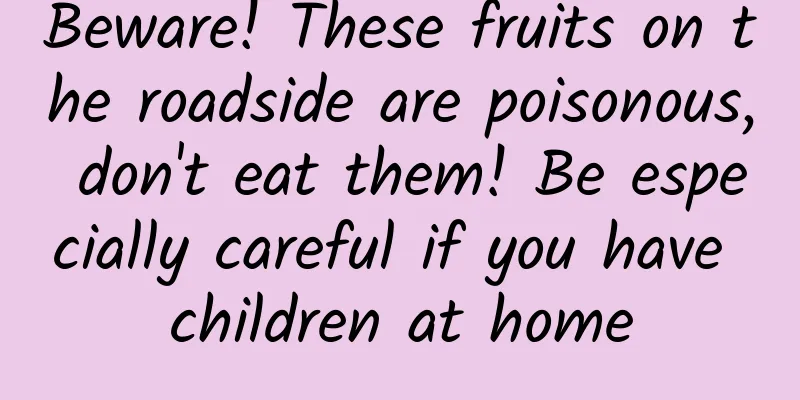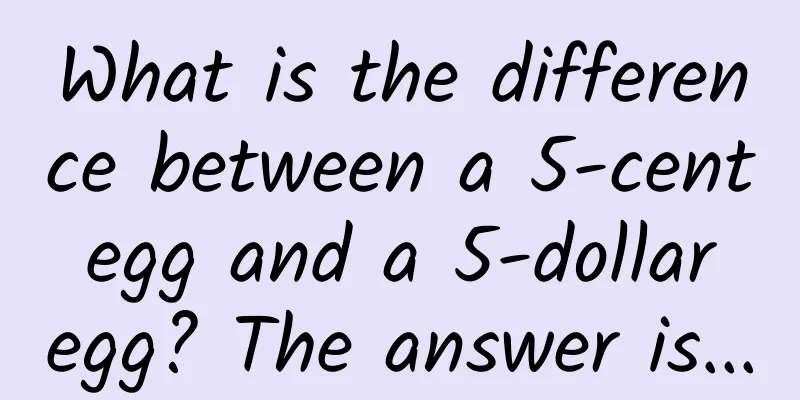Beware! These fruits on the roadside are poisonous, don't eat them! Be especially careful if you have children at home

|
Winter is here, and it is the season for bright red fruits to hang on the branches. Facing the "delicious" fruits that seem to be within reach on the roadside, I believe many friends have been tempted. But wait, because many fruits of ornamental plants cannot be eaten, and may even be poisonous! We have sorted out 5 kinds of poisonous fruits that are very common on the roadside and in the park. Don't pick them or try them casually. 1. Lonicera maackii On the streets of northern cities, you can easily see clusters of bright red berries hanging on the branches of small trees by the roadside, which are very tempting. They are the fruits of honeysuckle (also known as honeysuckle wood). They are called "honeysuckle" because their flowers are white when they first bloom and turn golden the next day. But don't confuse it with honeysuckle (Lonicera japonica) used for making tea. The latter mainly lives in the area south of the Yellow River. It is a vine plant with a distinct calyx and pure black fruits. Copyright images in the gallery. Reprinting and using them may lead to copyright disputes. Like other honeysuckle plants, honeysuckle flowers contain nectar, which can be plucked and sucked when in bloom - this is why honeysuckle is called "honeysuckle" in English, which literally means "honey, suck". However, whether it is honeysuckle or honeysuckle, all parts other than the nectar of the flowers are toxic, and the fruit is no exception. If eaten in large quantities, it may cause dizziness, headache, nausea, and even vomiting, and can lead to coma. The good news is that honeysuckle berries are not very toxic and are very bitter, so the risk of accidentally ingesting large quantities is not high. (As for how I know what it tastes like... you'd better not ask.) 2. Ilex spp. In southern China, there is a type of small tree covered with bright red fruits every winter. They are plants of the genus Ilex of the Aquifoliaceae family. Commonly used in gardening are native hollies, iron hollies, red-fruited hollies, hollies, etc. Occasionally, European hollies introduced as ornamental plants are also seen. Unlike honeysuckle, hollies are evergreen plants . Even in the coldest winter, their dark green, thick, leathery leaves are still green and lush. Copyright images in the gallery. Reprinting and using them may lead to copyright disputes. Some hollies are more "friendly" with oval leaves, while others have sharp serrations on the edges of their leaves - considering the hardness of their leaves, these serrations are quite prickly. The one that has gone the furthest on this path is the holly, which, with the help of keratin, has its leaf tips and edges transformed into light yellow translucent long thorns that are daunting. However, there is no need to feel sorry for the difficulty in picking the berries, because the berries of holly are also slightly toxic. Not only are they bitter and astringent, but eating too much can also cause vomiting and diarrhea . Ancient Westerners even used the berries of European holly as an emetic. 3. Nandina domestica In the Yangtze River Basin, Nandina domestica also produces large bunches of bright red fruits in autumn and winter every year. Nandina domestica is a plant of the Berberidaceae family. Although its colorful stems and leaves look a bit like bamboo, its bright fruits still betray it. Copyright images in the gallery. Reprinting and using them may lead to copyright disputes. Unlike the two red fruits mentioned above, if you accidentally eat too many Nandina domestica fruits, it may be a big deal. The entire Nandina domestica plant contains toxins, which will produce highly toxic hydrogen cyanide after degradation . In addition, their berries also contain other toxic alkaloids, which will cause diarrhea, vomiting and other gastrointestinal reactions after eating. Nandina domestica berries are unpalatable, so cyanide poisoning is unlikely to be a problem for adults, but they are dangerous to children and pets, and birds have been killed by eating the berries. 4. Taxus chinensis Equally deadly are the red "fruits" of the yew, or strictly speaking, "cones". Like pine and cypress, yew is a gymnosperm and does not produce true fruits. However, each of their seeds is wrapped in a cup-shaped red fleshy aril, which looks a bit like a fruit. Copyright images in the gallery. Reprinting and using them may lead to copyright disputes. The whole plant of yew is highly toxic. Theoretically, the red aril is the least toxic part, but eating too much can cause poisoning. The seeds wrapped in the aril are the most toxic, and a very small amount can cause serious poisoning symptoms. Yew poisoning can cause vomiting, diarrhea, dilated pupils, and muscle weakness at the mildest, and a series of heart problems such as tachycardia, bradycardia, hypotension, cardiac arrest, and even death. Taxol contained in yew is widely used in cancer treatment, but paclitaxel itself has no use for cancer prevention and suppression, and is only toxic. Do not be superstitious about folk prescriptions and drink water or medicinal wine soaked in yew. 5. Solanum pseudocapsicum Coral cherry, also known as four-season fruit, jade coral, and hairy winter coral, has appeared more and more in urban flower beds in recent years. It is a fruit-viewing plant of the Solanaceae family. Its bright orange to bright red fruits can hang on the branches for three months, which is its golden signboard. When you break open the fruit of the coral cherry, you will definitely feel that the seeds inside it look like pepper seeds - this is not surprising, after all, pepper is also a plant of the Solanaceae family, and its scientific name also says that it is a "false pepper." Copyright images in the gallery. Reprinting and using them may lead to copyright disputes. Some people say that the taste of coral cherry fruit is okay, which makes it more dangerous because the chance of accidental ingestion is greater. Fortunately, the toxicity of coral cherry fruit is not very strong (the stems and leaves are more toxic), and it is generally not considered to be fatal, but accidentally ingesting coral cherry fruit can still cause a strong gastrointestinal reaction, leading to nausea, vomiting, or gastroenteritis. As a botanical professional, I have tasted some less toxic plants during my research, but I have never had the courage to taste the coral cherry. After all, everyone should be more cautious when facing Solanaceae plants. Many highly toxic plants that make people shudder at the mere mention of them come from this group, such as Datura, Belladonna and Henbane. Why do we still grow poisonous plants? There are of course many more poisonous fruits in urban gardens than the ones listed above. There are also news reports of people being poisoned and sent to the hospital after eating garden plants. Some people may complain, why do we plant poisonous plants in cities? Isn't it safer if we don't plant them? But in fact, there are many more issues that gardeners need to consider than just "whether it is poisonous". Different plants have different uses. For gardens, beauty always comes first. Some poisonous plants have beautiful flowers, colors or shapes, so they are used in garden landscape decoration to add visual appeal to the city. Almost none of the bulb plants that support early spring flower beds are non-toxic, including tulips, daffodils, hyacinths, crocuses, lily of the valley, etc. We obviously cannot abandon the entire gorgeous spring just because of toxicity. Some poisonous plants are very resistant to stress and can thrive with very low management while maintaining an elegant appearance, making them a cost-effective choice. For example, although oleander is notorious for its extreme toxicity, it requires almost no care to maintain its beautiful shape and produce gorgeous flowers, so it is difficult to completely abandon it when designing a garden. There are also some poisonous plants that have established their foothold in culture, such as azalea, wintersweet, ginkgo, daffodil, etc. When doing garden design, it is difficult to skip the profound cultural connotations behind them. Copyright images in the gallery. Reprinting and using them may lead to copyright disputes. Do not eat fruits from roadside garden edibles In fact, not all horticultural plants are that dangerous. Many small red fruits on the roadside are non-toxic, such as the common crabapple, cotoneaster, pyracantha, heather, and cinnabar root. But if we want to put these fruits into our mouths, we still face a series of challenges: 1. Accurate identification of plants requires a wealth of knowledge and experience. We may not be able to accurately distinguish between poisonous plants and non-toxic plants by relying only on a few popular science articles on the Internet; 2. Horticultural plants are bred for their ornamental qualities rather than their taste, so their fruits are mostly unpalatable and not worth eating; 3. The urban garden environment is often seriously polluted, and the garden plants may be enriched with more heavy metals and other toxic substances; 4. In order to maintain the beauty of the city, a lot of pesticides are often sprayed on ornamental plants in gardens, which inevitably leave toxic substances. For these reasons, we strongly recommend that you do not eat the fruits of roadside garden plants . If you really want to eat them, you might as well plant some fruits in a flowerpot on the balcony. Strawberries, raspberries, and tomatoes are all suitable for beginners, but the yield is often restricted by the environment, so you can't eat them freely. Planning and production This article is a work of Science Popularization China-Starry Sky Project Produced by: Science Popularization Department of China Association for Science and Technology Producer|China Science and Technology Press Co., Ltd., Beijing Zhongke Xinghe Culture Media Co., Ltd. Author: Lao Mao, a popular science writer Review丨Wang Kang, Director of the Science Museum of the National Botanical Garden Planning丨Zhong Yanping Editor: Zhong Yanping |
<<: Understand "International Customs Day" in 80 seconds!
>>: Before traveling back home during the Spring Festival, read this guide before setting off!
Recommend
15 major brands play with private domain traffic, 5 strategies to increase growth!
As one of the most important festivals in the his...
Are the hazards of sitting for a long time so serious?
Everyone knows that sitting for a long time is ba...
Karaoke returns: an old friend of home entertainment and a new partner of smart TV
Looking back to more than a decade ago, setting u...
Growth Hacker: Amap’s Path to User Growth!
On October 1, Liu Zhenfei, Alibaba partner and pr...
The latest report from the World Meteorological Organization: AI is revolutionizing weather forecasting, making it faster, cheaper and more accessible
“We are still very far from meeting global climat...
Can workers who stay up late to work overtime still enjoy midnight snacks?
《Cotton Swab Medical Science Popularization》 Ren ...
[Promotion Case] How do e-commerce companies such as JD.com and Tmall as well as O2O build promotion systems and rules?
We see that there are many issues related to e-co...
Is the fruit and vegetable cleaning machine with monthly sales of over 2,000 worth buying? Test 3 models and tell you the answer
Pesticide residues have always been a concern for...
The reason why Android is lagging more than iOS has been found: it uses nearly 3 times more memory
When we mention Android and iOS, many people'...
Windows 10 Mobile Preview Experience: Great Evolution of Voice Recognition
Windows 10 is coming this year, and Microsoft has...
How does brand marketing capture user needs?
Some people regard cars as a means of transportat...
Frost Descent | Why does frost-bitten cabbage taste better?
=================================================...
Building an Android development environment under Linux
[[169961]] This article mainly introduces the con...









